The heart of the smartphone: which SoC to choose
We systematized data on various smartphone chips in order to more clearly show the difference between them and their performance. Packed all in one tablet and briefly told what came from.
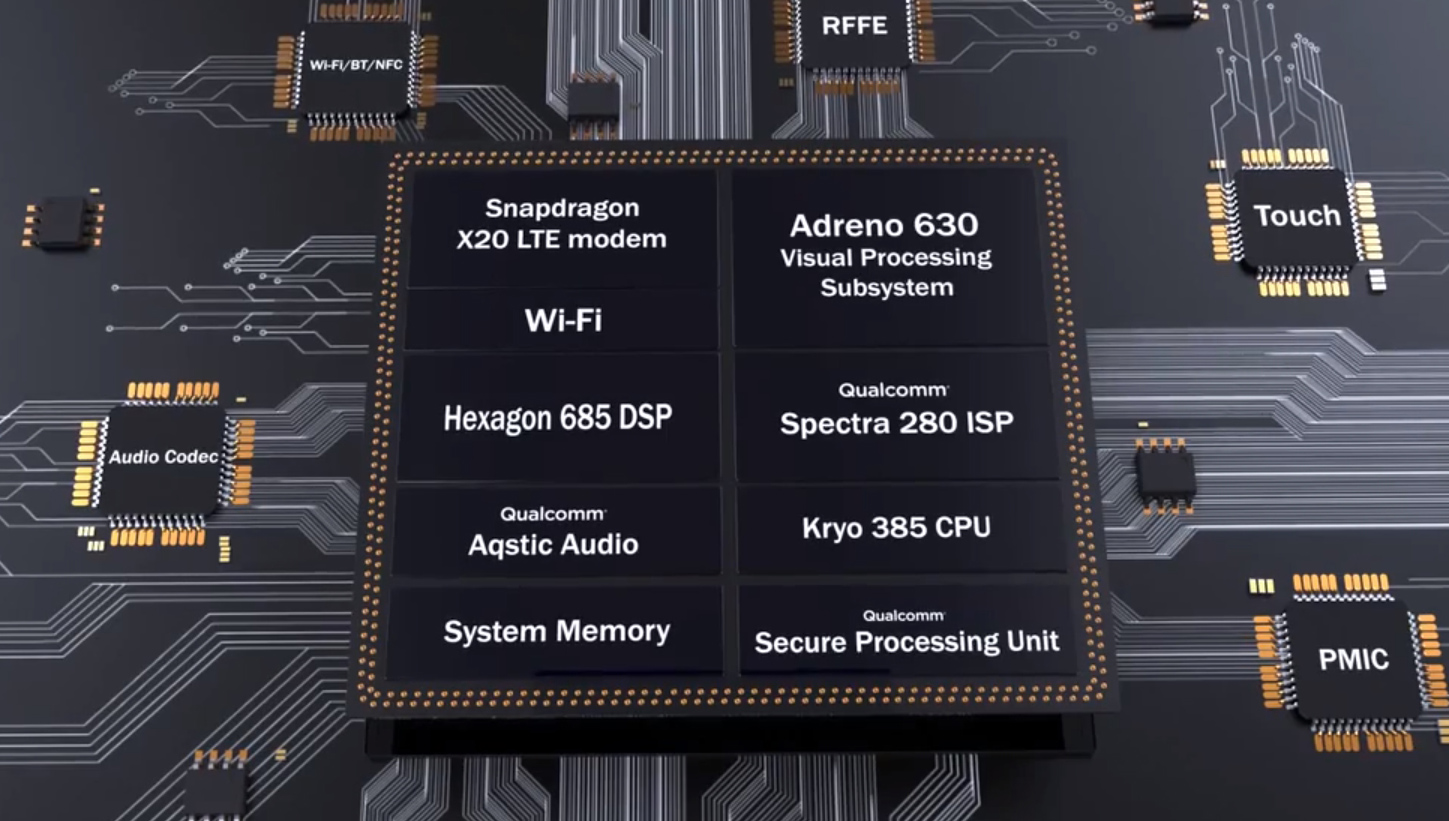
Each manufacturer has both successful models, where this balance is found, and frankly failures - where the forces threw on the high performance of all the cores, forgetting about the memory, leaving no reserve for simple tasks and not teaching the chip to work halfway. The purpose of this article is to show how the ARM architecture has evolved, which solutions are relevant now and which of them can be chosen for yourself, focusing on the scenario of using a smartphone.

The ARMv7 and ARMv8 families are considered to be the classic representation of the nuclear architectures used in the chips of modern smartphones. They formed the basis of many branches, both for the authorship of ARM Holdings itself and of other companies: Qualcomm, Apple, Samsung, Nvidia, etc. The ARMv8-A branch is now the most popular, which at one time opened a new era of massive 64-bit computing for mobile devices.
All current ARM Holdings computing cores for smartphones are combined into the Cortex-A family. The rest of the developers buy licenses for them from ARM and release their chips with minimal changes. But they can also rework the architecture itself or even create everything practically from scratch, retaining only the support of the corresponding set of instructions. For example, Apple, Samsung and some other companies are doing it. Samsung has Exynos M1, M2 and M3 cores. Apple has Monsoon, Mistral, Hurricane, etc. Nvidia has Denver2. Qualcomm has Kryo and others.
Now let's look at the most popular SoC of the main players in this market.
Qualcomm is considered a recognized leader in this field. Now the company’s portfolio includes several generations of successful SoCs that have been sold out to millions of copies worldwide. Let's look at the range and select the most interesting models.
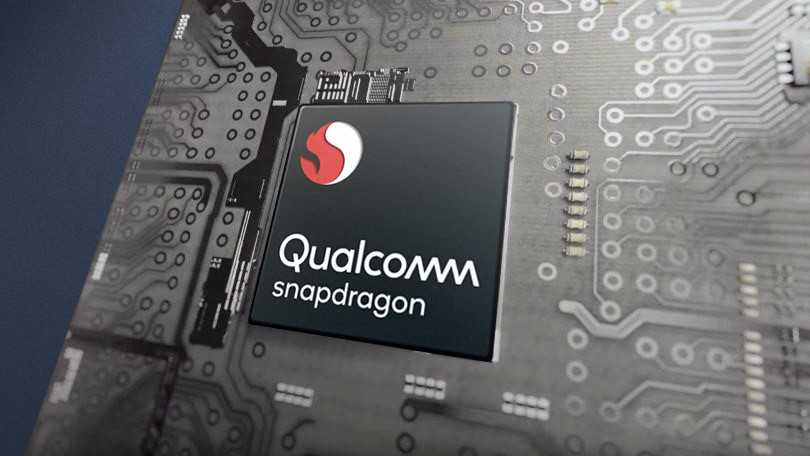
Snapdragon 4xx - a series of available SoC for smartphones. Perhaps this phrase is somewhat rude to them, but some manufacturers are trying to stick these SoCs under the pretext of concern for autonomy. Do not believe them. Although Snapdragon 4xx is really economical, efficiency is a consequence, not a cause.
Snapdragon 425, 427 - 4-core processors with support for single-channel LPDDR3 memory. They operate at frequencies up to 1.4 GHz and are based on the Cortex-A53 core (ARMv8 architecture).
Snapdragon 435 - 8-core processor with support for single-channel LPDDR3 memory. It operates at frequencies up to 1.4 GHz and is based again on the Cortex-A53.
The Snapdragon 450 series also uses a layout of 8 cores, but is produced using a 14 nm process technology. The frequencies were increased to 1.8 GHz, and the integrated video core got support for resolutions from WUXGA to Full HD + (aspect ratio of 18 to 9). The Snapdragon 450 still uses the Cortex-A53 (ARMv8) and single-channel LPDDR3 memory.
Snapdragon 625 and 626 - the SoC lineup is the first QC 3.0 that received charging and is manufactured according to the standards of 14 nm FinFET. This reduced the power consumption of the CPU part. However, there are not so many differences from the 4xx series: the grown frequency is up to 2 GHz for 625 and 2.2 GHz for 626.
Snapdragon 653 is the first mid-tier SoC created using BIG.Little technology. It is based on a bundle of 4 Cortex-A72 cores (up to 1.95 GHz) and 4 Cortex-A53 cores at a frequency of up to 1.45 GHz. A dual-channel LPDDR3 memory and graphics core with normal performance appears. Snapdragon 653 phones can be equipped with displays with a resolution of 2560x1600 pixels.
Snapdragon 630, 636 and 660 - here stands out exactly 630 chip, because he ended his life before he could start it. Its structure was relatively simple: 8 identical cores of Cortex-A53 (ARMv8) were divided into 2 clusters of 4, in production it went straight to the 14 nm process technology. Dual-channel LPDDR4 was used as memory. Literally in the same year, Qualcomm concluded that the Snapdragon 630 configuration was not entirely successful and updated it to 636. It uses four faster cores Cortex-A73 and four Cortex-A53. Snapdragon 636 and 660 are the same SoC with differences in the maximum frequency of operation (1.8 GHz versus 2.2 GHz), different graphics cores and a slightly higher memory frequency in 660.
Snapdragon 835 and 845 are the Qualcomm flagships used in the most advanced mobile phones (and even netbooks). Both are available on 10 nm process technology in Samsung factories. Possess 8 cores in the BIG.little configuration. Snapdragon 835 is the integration of four ARM Cortex-A73 cores (ARMv8-A) and as many as Kryo 280 (modified Cortex-A73 core). QC 4.0 support introduced. Used dual-channel memory of the new standard - LPDDR4X. The graphics core of the Adreno 540, even by the standards of 2018, is very, very fast.

In Snapdragon 845 for the first time installed two pairs of cores Kryo 385 Gold and Silver. The Kryo 385 Gold is based on the Cortex-A75 version (ARMv8.2-A), while the Silver is Cortex-A55 (ARMv8.2-A). This is the next step in the development of BIG.little technology. Now Qualcomm calls it ARM DynamIQ. The frequencies of the Kryo 385 Gold reach 2.8 GHz, and the weaker cores of the Kryo 385 Silver, on the contrary, are reduced to 1.8 GHz.
When reading the specifications, you understand that the company is a real boon for smartphone makers: they still produce cheap SoC with a bunch of cores. You take one and make a phone costing less than $ 100-200 with the words: “8 cores, 64-bit, etc.!”. In fact, MediaTek makes good SoCs, but cross them with a mediocre strapping, so buyers are wary of such phones. And yet among the wide range of MediaTek is really massive processors ARM. Good solutions can be called two lines - Helio P and X. The first refers to the middle segment, and the second for advanced smartphones.
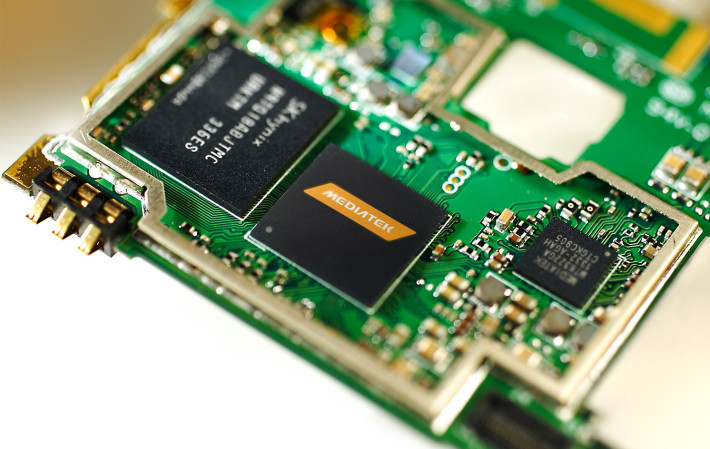
The Helio P30, P25 and P20 series are 8-core 4 + 4 chips, consisting of A53 cores. From the advantages of Helio - modern LPDDR4x memory, which certainly affects the graphics tests. In processor tests, the difference between the three versions of SoC is not great. MediaTek focused on the development of auxiliary characteristics of SoC, such as support for high-resolution screen, dual cameras and the like.
The older chips X27 and X30 are unique in their structure. They are not two, but three clusters of core ARM. Well, the solution is extraordinary and interesting. In practice, it is even more difficult to evaluate the performance of such a scheme, because they work separately depending on the loads.
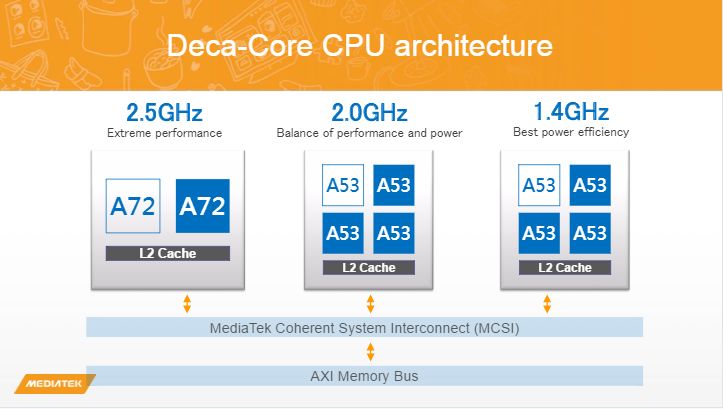
Another player on the market, preferring their own development. In general, Huawei has been making its way to Olympus for years and decided to start developing SoC, of course, using the ARM license. In general, these are typical SoCs with familiar characteristics, except for the desire of Huawei to keep up with the times. Therefore, elements of processing artificial intelligence tasks like the NPU co-processor are gradually being introduced into the SoC. In addition, Huawei has large research centers in Europe. Did Huawei succeed in catching up with the leaders, we will see now.

Kirin 6xx - for mobile phones of an average price category. These SoCs compete with Snapdragon 4xx. They have 8 cores in 4 + 4 configuration. Alas, graphics performance is not enough. This is the main drawback of the 6xx series. Kirin 658, 655 and 650 are very similar to each other. Huawei gradually accelerates them and changes the indices. At the same time, the graphic part remains unchanged and is based on the Mali-T830 MP2 core. There is support for LPDDR3 memory already retiring. A revision was made for 658 and an updated communication module (802.11 b / g / n / ac) appeared. But still more interesting are the older versions of the 9xx.
Kirin 9xx. These 8-core SoCs are somewhat faster than the Mediatek Helio X line, although they have fewer cores. SoCs turned out to be standard, without innovations, but they work perfectly and allow us to save company funds. In general, the Kirin 970, 960, 955 trio have typical characteristics that show how evolution proceeds. 955, possessing a set of A72 + A53 cores, eventually changed them to A73 + A53. The frequencies have gone down, power consumption has fallen, and due to internal optimizations of the A73 cores, it turned out to be on performance somewhere between Snapdragon 835 and 660. Therefore, the next step with replacing with faster memory gave an impetus that allows Snapdragon 835 to stand up to equal results. exceed the performance of 10-core Helio, which Huawei apparently pursued.
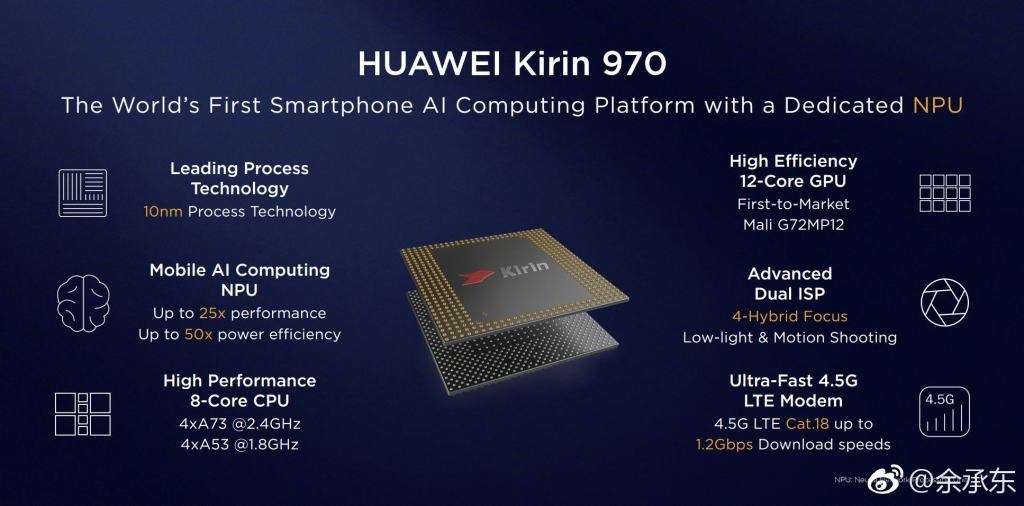
Separately, it must be said about the performance of the NPU coprocessor, because the result is indeed curious. As many review authors point out, Kirin 970-based smartphones demonstrate good autonomy primarily due to the transfer of some specific calculations to the coprocessor — for example, when operating the camera and defining shooting scenarios. It also speeds up the tasks characteristic of AI applications. Plus analyzes the scenarios of using a smartphone, preparing them in advance for launching or putting them to sleep for better autonomy.
The flagship Samsung devices are characterized by duality: they are on the market as models based on Snapdragon chips, which are a surprise! - are made on the lines of Samsung, and on the basis of its own SoC Exynos. Interestingly, Exynos is made on a similar process technology as Snapdragon, but they have a clear performance advantage. There are several versions of why Koreans do just that. The most plausible is the idea that for US users (namely, models with a “dragon” on board are sold) would have to license some technologies like CDMA, while Qualcomm already has them. In any case, the result is very good.
So, Exynos 8895 installed in the Samsung S8, had four own M2 Mongoose cores with a frequency of 2.1 GHz and four A53 cores with a frequency of 1.7 GHz. In the updated Exynos 9810, the cores were upgraded to M3 Mongoose, simultaneously increasing the frequency to 2.9 GHz, and four low-performing cores were updated to A55. The videos were upgraded to the Mali G72, which made it again one of the most high-performance solutions along with the Adreno 630 in Snapdragon 845.

As a result, the Samsung S9 + based on Exynos on synthetic tests is considered the fastest Android smartphone and bypasses similar models on Snapdragon.
At the same time, they are not the flagship ones. Samsung also produces strong middling - a series of Galaxy A - on the basis of its own processors again. Last year's A7 was based on Exynos 7 Octa 7880: 8 Cortex A53 cores with a frequency of 1.9 GHz, Mali-G71 MP2 and dual-channel LPDDR4 memory.
Soc's characteristics allowed it to compete with Snapdragon 625 on equal terms. In the upcoming Galaxy A8, the new Exynos 7 Octa 7885, in which two cores were replaced with A73, increased frequencies to 2.2 GHz, and for the remaining six A53 reduced the frequency to 1.6 GHz. Thus, it was possible to increase productivity and increase autonomy.
Interestingly, the Octa 7885 has, one might say, younger brother, Exynos 5 Hexa 7872, in which there are two older A73 (with frequencies of 2 GHz) and 4 A53 operating at even lower 1.4 GHz. The first smartphones based on this chip are about to go into series and promise a good price / performance ratio.
To make it easier for you to understand all this diversity, we have collected all the main characteristics into a table, adding there averaged Geekbench4 test results from an open database of the developer company and the official rating . As well as the results of GFXBench: Manhattan. (Click to enlarge) Considering the table it is important to remember that many smartphone applications are still poorly sharpened for multi-threading, so the performance per core displayed in the Geekbench 4 Single test is also a very important indicator.
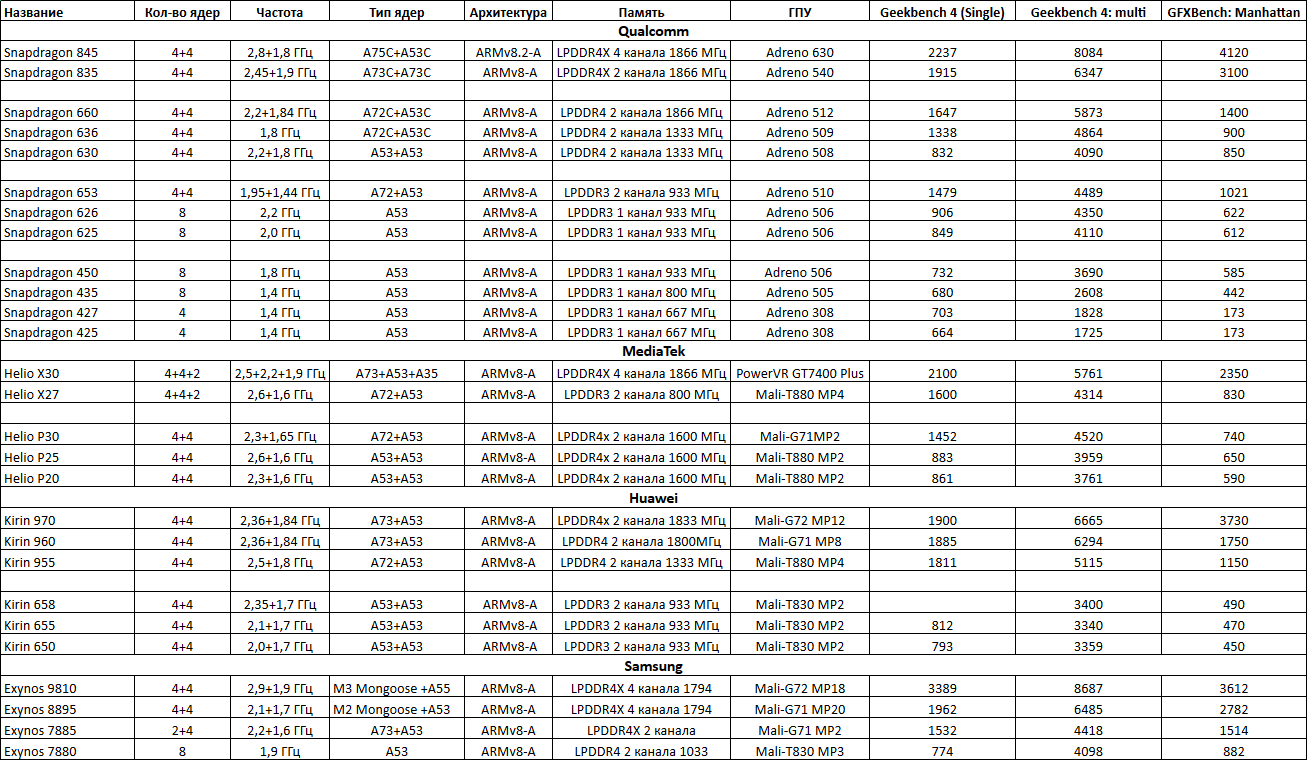
The main conclusion that can be made by considering this whole “zoo” is that despite the level of customization of the nuclei, it is their family that determines the final performance. If you want to get a high-performance solution, then choose the version of the smartphone with SoC, which contains the core Cortex-A72, A73 or A75. But if the tenths of a second in the response of the smartphone are not important to you, but there is a desire to save, then the Cortex-A53 will suit you completely.
Also, do not forget that a slow RAM or less than 2 GB of its RAM can “strangle” any high-performance processor.

Each manufacturer has both successful models, where this balance is found, and frankly failures - where the forces threw on the high performance of all the cores, forgetting about the memory, leaving no reserve for simple tasks and not teaching the chip to work halfway. The purpose of this article is to show how the ARM architecture has evolved, which solutions are relevant now and which of them can be chosen for yourself, focusing on the scenario of using a smartphone.

ARM and major family versions
The ARMv7 and ARMv8 families are considered to be the classic representation of the nuclear architectures used in the chips of modern smartphones. They formed the basis of many branches, both for the authorship of ARM Holdings itself and of other companies: Qualcomm, Apple, Samsung, Nvidia, etc. The ARMv8-A branch is now the most popular, which at one time opened a new era of massive 64-bit computing for mobile devices.
All current ARM Holdings computing cores for smartphones are combined into the Cortex-A family. The rest of the developers buy licenses for them from ARM and release their chips with minimal changes. But they can also rework the architecture itself or even create everything practically from scratch, retaining only the support of the corresponding set of instructions. For example, Apple, Samsung and some other companies are doing it. Samsung has Exynos M1, M2 and M3 cores. Apple has Monsoon, Mistral, Hurricane, etc. Nvidia has Denver2. Qualcomm has Kryo and others.
Now let's look at the most popular SoC of the main players in this market.
Qualcomm and the Snapdragon line
Qualcomm is considered a recognized leader in this field. Now the company’s portfolio includes several generations of successful SoCs that have been sold out to millions of copies worldwide. Let's look at the range and select the most interesting models.

Snapdragon 4xx - a series of available SoC for smartphones. Perhaps this phrase is somewhat rude to them, but some manufacturers are trying to stick these SoCs under the pretext of concern for autonomy. Do not believe them. Although Snapdragon 4xx is really economical, efficiency is a consequence, not a cause.
Snapdragon 425, 427 - 4-core processors with support for single-channel LPDDR3 memory. They operate at frequencies up to 1.4 GHz and are based on the Cortex-A53 core (ARMv8 architecture).
Snapdragon 435 - 8-core processor with support for single-channel LPDDR3 memory. It operates at frequencies up to 1.4 GHz and is based again on the Cortex-A53.
The Snapdragon 450 series also uses a layout of 8 cores, but is produced using a 14 nm process technology. The frequencies were increased to 1.8 GHz, and the integrated video core got support for resolutions from WUXGA to Full HD + (aspect ratio of 18 to 9). The Snapdragon 450 still uses the Cortex-A53 (ARMv8) and single-channel LPDDR3 memory.
Snapdragon 625 and 626 - the SoC lineup is the first QC 3.0 that received charging and is manufactured according to the standards of 14 nm FinFET. This reduced the power consumption of the CPU part. However, there are not so many differences from the 4xx series: the grown frequency is up to 2 GHz for 625 and 2.2 GHz for 626.
Snapdragon 653 is the first mid-tier SoC created using BIG.Little technology. It is based on a bundle of 4 Cortex-A72 cores (up to 1.95 GHz) and 4 Cortex-A53 cores at a frequency of up to 1.45 GHz. A dual-channel LPDDR3 memory and graphics core with normal performance appears. Snapdragon 653 phones can be equipped with displays with a resolution of 2560x1600 pixels.
Snapdragon 630, 636 and 660 - here stands out exactly 630 chip, because he ended his life before he could start it. Its structure was relatively simple: 8 identical cores of Cortex-A53 (ARMv8) were divided into 2 clusters of 4, in production it went straight to the 14 nm process technology. Dual-channel LPDDR4 was used as memory. Literally in the same year, Qualcomm concluded that the Snapdragon 630 configuration was not entirely successful and updated it to 636. It uses four faster cores Cortex-A73 and four Cortex-A53. Snapdragon 636 and 660 are the same SoC with differences in the maximum frequency of operation (1.8 GHz versus 2.2 GHz), different graphics cores and a slightly higher memory frequency in 660.
Snapdragon 835 and 845 are the Qualcomm flagships used in the most advanced mobile phones (and even netbooks). Both are available on 10 nm process technology in Samsung factories. Possess 8 cores in the BIG.little configuration. Snapdragon 835 is the integration of four ARM Cortex-A73 cores (ARMv8-A) and as many as Kryo 280 (modified Cortex-A73 core). QC 4.0 support introduced. Used dual-channel memory of the new standard - LPDDR4X. The graphics core of the Adreno 540, even by the standards of 2018, is very, very fast.

In Snapdragon 845 for the first time installed two pairs of cores Kryo 385 Gold and Silver. The Kryo 385 Gold is based on the Cortex-A75 version (ARMv8.2-A), while the Silver is Cortex-A55 (ARMv8.2-A). This is the next step in the development of BIG.little technology. Now Qualcomm calls it ARM DynamIQ. The frequencies of the Kryo 385 Gold reach 2.8 GHz, and the weaker cores of the Kryo 385 Silver, on the contrary, are reduced to 1.8 GHz.
MediaTek
When reading the specifications, you understand that the company is a real boon for smartphone makers: they still produce cheap SoC with a bunch of cores. You take one and make a phone costing less than $ 100-200 with the words: “8 cores, 64-bit, etc.!”. In fact, MediaTek makes good SoCs, but cross them with a mediocre strapping, so buyers are wary of such phones. And yet among the wide range of MediaTek is really massive processors ARM. Good solutions can be called two lines - Helio P and X. The first refers to the middle segment, and the second for advanced smartphones.

The Helio P30, P25 and P20 series are 8-core 4 + 4 chips, consisting of A53 cores. From the advantages of Helio - modern LPDDR4x memory, which certainly affects the graphics tests. In processor tests, the difference between the three versions of SoC is not great. MediaTek focused on the development of auxiliary characteristics of SoC, such as support for high-resolution screen, dual cameras and the like.
The older chips X27 and X30 are unique in their structure. They are not two, but three clusters of core ARM. Well, the solution is extraordinary and interesting. In practice, it is even more difficult to evaluate the performance of such a scheme, because they work separately depending on the loads.

Huawei kirin
Another player on the market, preferring their own development. In general, Huawei has been making its way to Olympus for years and decided to start developing SoC, of course, using the ARM license. In general, these are typical SoCs with familiar characteristics, except for the desire of Huawei to keep up with the times. Therefore, elements of processing artificial intelligence tasks like the NPU co-processor are gradually being introduced into the SoC. In addition, Huawei has large research centers in Europe. Did Huawei succeed in catching up with the leaders, we will see now.

Kirin 6xx - for mobile phones of an average price category. These SoCs compete with Snapdragon 4xx. They have 8 cores in 4 + 4 configuration. Alas, graphics performance is not enough. This is the main drawback of the 6xx series. Kirin 658, 655 and 650 are very similar to each other. Huawei gradually accelerates them and changes the indices. At the same time, the graphic part remains unchanged and is based on the Mali-T830 MP2 core. There is support for LPDDR3 memory already retiring. A revision was made for 658 and an updated communication module (802.11 b / g / n / ac) appeared. But still more interesting are the older versions of the 9xx.
Kirin 9xx. These 8-core SoCs are somewhat faster than the Mediatek Helio X line, although they have fewer cores. SoCs turned out to be standard, without innovations, but they work perfectly and allow us to save company funds. In general, the Kirin 970, 960, 955 trio have typical characteristics that show how evolution proceeds. 955, possessing a set of A72 + A53 cores, eventually changed them to A73 + A53. The frequencies have gone down, power consumption has fallen, and due to internal optimizations of the A73 cores, it turned out to be on performance somewhere between Snapdragon 835 and 660. Therefore, the next step with replacing with faster memory gave an impetus that allows Snapdragon 835 to stand up to equal results. exceed the performance of 10-core Helio, which Huawei apparently pursued.

Separately, it must be said about the performance of the NPU coprocessor, because the result is indeed curious. As many review authors point out, Kirin 970-based smartphones demonstrate good autonomy primarily due to the transfer of some specific calculations to the coprocessor — for example, when operating the camera and defining shooting scenarios. It also speeds up the tasks characteristic of AI applications. Plus analyzes the scenarios of using a smartphone, preparing them in advance for launching or putting them to sleep for better autonomy.
Samsung
The flagship Samsung devices are characterized by duality: they are on the market as models based on Snapdragon chips, which are a surprise! - are made on the lines of Samsung, and on the basis of its own SoC Exynos. Interestingly, Exynos is made on a similar process technology as Snapdragon, but they have a clear performance advantage. There are several versions of why Koreans do just that. The most plausible is the idea that for US users (namely, models with a “dragon” on board are sold) would have to license some technologies like CDMA, while Qualcomm already has them. In any case, the result is very good.
So, Exynos 8895 installed in the Samsung S8, had four own M2 Mongoose cores with a frequency of 2.1 GHz and four A53 cores with a frequency of 1.7 GHz. In the updated Exynos 9810, the cores were upgraded to M3 Mongoose, simultaneously increasing the frequency to 2.9 GHz, and four low-performing cores were updated to A55. The videos were upgraded to the Mali G72, which made it again one of the most high-performance solutions along with the Adreno 630 in Snapdragon 845.

As a result, the Samsung S9 + based on Exynos on synthetic tests is considered the fastest Android smartphone and bypasses similar models on Snapdragon.
At the same time, they are not the flagship ones. Samsung also produces strong middling - a series of Galaxy A - on the basis of its own processors again. Last year's A7 was based on Exynos 7 Octa 7880: 8 Cortex A53 cores with a frequency of 1.9 GHz, Mali-G71 MP2 and dual-channel LPDDR4 memory.
Soc's characteristics allowed it to compete with Snapdragon 625 on equal terms. In the upcoming Galaxy A8, the new Exynos 7 Octa 7885, in which two cores were replaced with A73, increased frequencies to 2.2 GHz, and for the remaining six A53 reduced the frequency to 1.6 GHz. Thus, it was possible to increase productivity and increase autonomy.
Interestingly, the Octa 7885 has, one might say, younger brother, Exynos 5 Hexa 7872, in which there are two older A73 (with frequencies of 2 GHz) and 4 A53 operating at even lower 1.4 GHz. The first smartphones based on this chip are about to go into series and promise a good price / performance ratio.
Comparative table of performance SoC
To make it easier for you to understand all this diversity, we have collected all the main characteristics into a table, adding there averaged Geekbench4 test results from an open database of the developer company and the official rating . As well as the results of GFXBench: Manhattan. (Click to enlarge) Considering the table it is important to remember that many smartphone applications are still poorly sharpened for multi-threading, so the performance per core displayed in the Geekbench 4 Single test is also a very important indicator.

findings
The main conclusion that can be made by considering this whole “zoo” is that despite the level of customization of the nuclei, it is their family that determines the final performance. If you want to get a high-performance solution, then choose the version of the smartphone with SoC, which contains the core Cortex-A72, A73 or A75. But if the tenths of a second in the response of the smartphone are not important to you, but there is a desire to save, then the Cortex-A53 will suit you completely.
Also, do not forget that a slow RAM or less than 2 GB of its RAM can “strangle” any high-performance processor.
